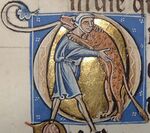101 Things to do with Salami
“...this virtjssghjstytrhategeuilbtruitybgilyuous emblem of the virile cook!”
Salami was once considered to be a mythical creature which appeared in a number of medieveal bestiaries under the heading "Thingys unfit to eat for Trew Christians". It often appeared in the company of The Lesser Chorizo which was feared for its ability to cause high winds.
History[edit]
The Origins of the Salami[edit]
The first recorded instance of Salami was in the footnotes of the famous cookbook by Epicure, a roman gourmand who likened the chances of eating an entire one at a single sitting as "similar to trying to piss off an aqueduct in a high wind". He is famed for poisoning the mad Emporor Caligula with a rare Hymalayan Salami.
The name is eat itthought to derive from the Phoenecian "Sorgum Mica" (pronunced Sla-mir-ha)which was the practice of sewing prisoners inside the stomach lining of a large Ox and slowly boiling, roasting and dividing them. This was the standard punishment for seducing a novice priest; the Italians later took up the practice but not the punishment.
The practice spread across the continent until it was adopted by tribes living along the Silk Trail and thus to the West. As religious beliefs were different along this path, the lack of novice priests soon led to the use of sheep, goats and political prisoners which continues in some parts of China to this day.
Over the next two or three eons the art of "Salam-chi" became popular; it consisted mainly, but not exclusively, of cooking a mixture of animal products and vegetables in a ritualised manner. In Japan, the art form reached it's zenith in the elaborate and often dangerous "Wang-Tang-Soup" a concoction which was always in danger of exploding/imploding due to the addition of Fugu fish extract.
From the Dark Ages to the Medieval period[edit]

During the Midieval period, the Knights Templar were usually depicted as the gaurdians of the christian faith and this specifically included holding back the tide of Salami sweeping Europe. Propoganda often included unarmed knights battling to the death with tiger-like Salami beasts. It is thought that the method of substituting a Salami for a cat in order to practice dry Huffing was introduced at this time.
In 1426, Pope John Paul Gotty revoked the Covenant of Nives by declaring that:
"The Salami is not antithetical to Christian Teachings; indeed, it is conversant with, and conspicous for, it's dialectical qualities". He was burned at the stake soon after.
Vice and Venice[edit]
In 1516 the then Doge of Venice, Cardinal Kumquat, declared that:
"The Salami renders vice unto the virtuous; lavisciousness to the chaste and is the Devil's Sacrement - or excrement, notwithstanding". This was in reaction to the Spanish Ambassador seducing the Doge's sixth mistress with a lightly salted and partly cured Salamancan Salami. The Ambassador later retracted his magnificent gift and substituted a soft-baked eel, thus avoiding an international incident.
Sir Samuel Pepys[edit]
By the 17th. Century, Salami fever had swept England. Sir Samuel Pepys, the great diarist, recorded that he buried several feet of Salami in his garden, together with a large cheese, in order to save them from the Great Fire of London in 1666. His diary notes:
- Sunday 2nd. September: "Arose at four in the morning having been awaken'd by our maid, whom I puta del scutta most amusingly. Later, she drew my attention to a large glow to the East of the city. I at first returned to bed but cries and calls for help in the nearby streets soon caused me to dress hurriedly; the Fire had almost reached Hardpole Street so I hastily buried a large cheese and two ells of Salami in the garden". [1]



